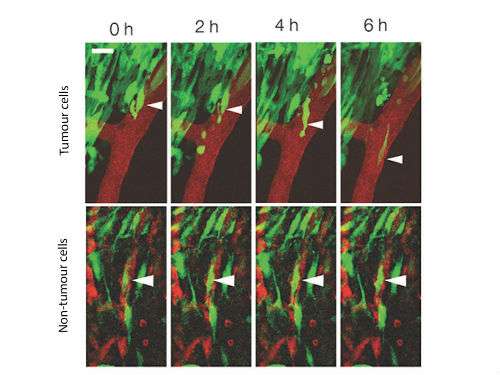Study identifies new approach that could help prevent spread of deadly brain tumour

A new study, published today in the journal eLife, has identified a protein that if targeted could help to prevent the spread of the most common and deadly form of brain tumours - glioblastomas.
Researchers at the MRC Clinical Sciences Centre based at Imperial College London tested mice implanted with tumour cells and found that targetting a protein called ephrin-B2 has two effects; it halts the division of cancer cells, and stops them spreading.
Glioblastomas have thread-like stems, which can easily spread into healthy brain tissue. This makes them particularly hard to treat as it is not possible to completely remove the tumours by surgery alone. It also means there is a high rate of recurrence of the disease.
The team behind the study however hope that with further research this two-in-one approach could one day lead to a much-needed new treatment.
Scientists are not exactly clear how cancerous tumour cells invade the brain in patients with glioblastomas, but they know that a key route is through the space that surrounds blood vessels. This particular type of invasion is called 'perivascular invasion'.
The researchers used a cutting-edge technique called intravital imaging to watch this invasion within a mouse brain in real time. They observed that when healthy cells first develop non-cancerous mutations, blood vessels within the brain keep them in a compartment so that they cannot spread and cause damage. They found that the vessels do this by producing ephrin-B2, which appears to immobilise the cells and hold them in place. However, when the cells become cancerous, they are able to override this signal and escape.

The team showed that the cancerous cells do this by producing their own ephrin-B2, which makes them insensitive to the ephrin-B2 already in the blood vessels stopping the cells from spreading.
In addition, the researchers observed a positive feedback effect alongside the raised levels of ephrin-B2, and found at high levels, the protein appears to act as a signal, telling the cells to divide.
The team therefore attempted to block the protein in a mouse model implanted with tumour cells from human patients. They discovered that the tumour cells were then unable to divide and spread throughout the brain, and this resulted in tumours shrinking in size and the treated mice outliving those that did not receive the treatment - with some tumours disappearing completely.
Dr Simona Parrinello, lead author of the study and group leader at the MRC Clinical Sciences Centre, said "The ephrin-B2 protein is complex but in this case it works in our favour. By blocking one molecule we affect two key aspects of tumours; their ability to divide and their ability to invade. It could be a combined therapy in one."
Dr Adam Babbs, programme manager for cancer research at the MRC, said: "These types of brain tumours are not only the most common but also the most difficult to treat. The MRC's investment in high quality brain tumour research is advancing our knowledge of how the disease works and could help in the search for a more effective treatment."
The team now plan to test whether this protein plays a role in the spread of other types of brain tumours, with the aim of a treatment that can be tested in patients.


















